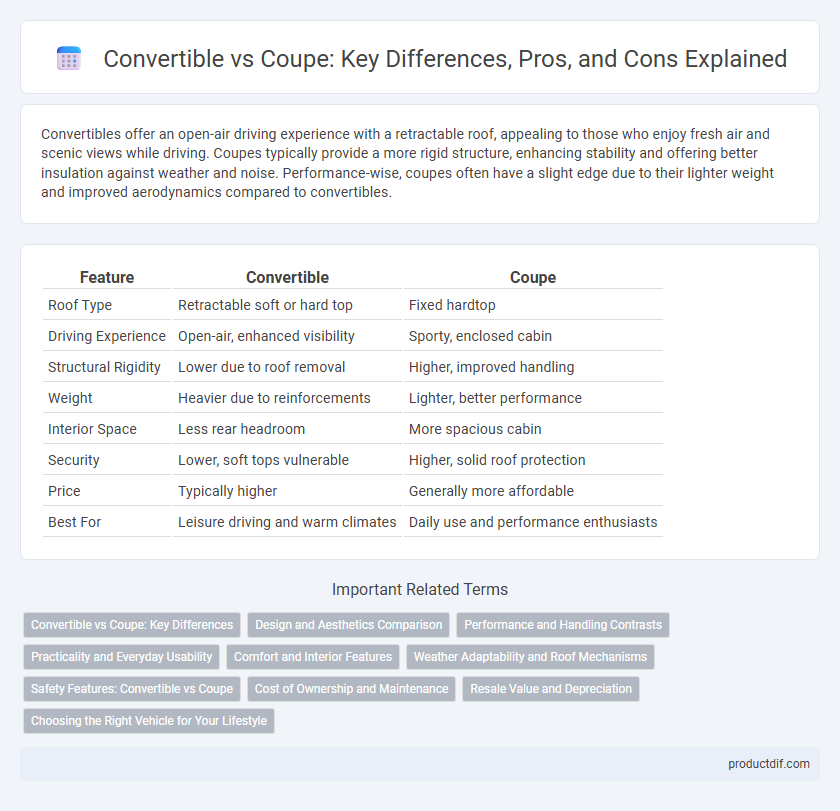Convertibles offer an open-air driving experience with a retractable roof, appealing to those who enjoy fresh air and scenic views while driving. Coupes typically provide a more rigid structure, enhancing stability and offering better insulation against weather and noise. Performance-wise, coupes often have a slight edge due to their lighter weight and improved aerodynamics compared to convertibles.
Table of Comparison
| Feature | Convertible | Coupe |
|---|---|---|
| Roof Type | Retractable soft or hard top | Fixed hardtop |
| Driving Experience | Open-air, enhanced visibility | Sporty, enclosed cabin |
| Structural Rigidity | Lower due to roof removal | Higher, improved handling |
| Weight | Heavier due to reinforcements | Lighter, better performance |
| Interior Space | Less rear headroom | More spacious cabin |
| Security | Lower, soft tops vulnerable | Higher, solid roof protection |
| Price | Typically higher | Generally more affordable |
| Best For | Leisure driving and warm climates | Daily use and performance enthusiasts |
Convertible vs Coupe: Key Differences
Convertibles offer an open-air driving experience with retractable roofs, enhancing versatility and enjoyment in favorable weather, while coupes feature fixed roofs that provide better structural rigidity and typically superior handling dynamics. Weight differences exist, as convertibles tend to be heavier due to added reinforcement for roof mechanisms, impacting acceleration and fuel efficiency compared to lighter coupes. Safety features also vary, with coupes generally offering better rollover protection, whereas convertibles compensate with reinforced frames and advanced airbag systems.
Design and Aesthetics Comparison
Convertibles feature a retractable roof that enhances open-air driving experiences and offers a dynamic, sleek profile, often appealing to those valuing versatility and style. Coupes maintain a fixed hardtop design, emphasizing a streamlined, aerodynamic shape that conveys sportiness and elegance with a more rigid structural integrity. Both designs cater to different aesthetic preferences, with convertibles prioritizing freedom and visual flair, while coupes focus on a polished, cohesive silhouette.
Performance and Handling Contrasts
Convertibles often weigh more than coupes due to reinforced frames for structural rigidity, which can slightly reduce acceleration and cornering precision compared to the lighter, stiffer coupe chassis. Coupes typically offer superior handling dynamics with a lower center of gravity and enhanced chassis stiffness, allowing for more responsive steering and better grip during aggressive driving. Performance metrics such as 0-60 mph times and lap times generally favor coupes, emphasizing their advantage in track and spirited driving scenarios.
Practicality and Everyday Usability
Convertibles offer open-air driving pleasure but often sacrifice trunk space and rear seat comfort, limiting practicality for daily use and family transport. Coupes provide better structural rigidity, enhanced security, and greater cargo capacity, making them more suitable for everyday commuting and long-term usability. Choosing between the two depends on balancing lifestyle priorities with functional needs such as storage and passenger accommodation.
Comfort and Interior Features
Convertibles offer an open-air driving experience but often sacrifice interior space and insulation, resulting in increased cabin noise and less effective climate control compared to coupes. Coupes typically provide more comfortable seating with better headroom and advanced interior features such as enhanced soundproofing, premium upholstery, and integrated infotainment systems. The coupe's fixed roof structure contributes to superior structural rigidity, enhancing ride comfort during long drives.
Weather Adaptability and Roof Mechanisms
Convertibles feature retractable roofs that enhance weather adaptability by allowing drivers to switch between open-air and enclosed driving, ideal for varying climates. Coupes have fixed roofs, providing superior insulation and durability against harsh weather conditions but lacking the versatility of convertibles. Advanced soft-top and hardtop convertible mechanisms offer quick, automated roof transitions, balancing convenience and protection in changing weather.
Safety Features: Convertible vs Coupe
Convertibles typically offer lower structural rigidity compared to coupes, impacting crash protection and rollover safety. Advanced safety features in coupes, such as reinforced roofs and side-impact bars, provide enhanced occupant protection. Modern convertibles compensate with strengthened frames and deployable rollover protection systems to improve overall safety.
Cost of Ownership and Maintenance
Convertibles generally incur higher maintenance and ownership costs compared to coupes due to their complex retractable roof mechanisms and increased exposure to weather-related wear. Repairing or replacing convertible tops can be expensive, while coupes benefit from a simpler, fixed roof structure that typically demands less upkeep. Insurance premiums for convertibles are also often higher, reflecting increased risk factors associated with their design.
Resale Value and Depreciation
Convertible vehicles typically experience slower depreciation compared to coupes due to their limited production and higher demand among enthusiasts. Coupes often have a broader market appeal but face steeper resale value declines as they depreciate faster over time. Factors such as brand reputation, vehicle condition, and model popularity significantly influence the resale value and depreciation rates in both body styles.
Choosing the Right Vehicle for Your Lifestyle
Choosing between a convertible and a coupe depends on your lifestyle needs and driving preferences. Convertibles offer open-air freedom ideal for enjoyable weekend drives and warmer climates, while coupes provide a sleek, aerodynamic design with enhanced structural rigidity and better insulation suited for daily commutes and varying weather conditions. Evaluating factors such as climate, usage frequency, passenger capacity, and storage requirements will help determine the best vehicle type to complement your lifestyle.
Convertible vs Coupe Infographic

 productdif.com
productdif.com